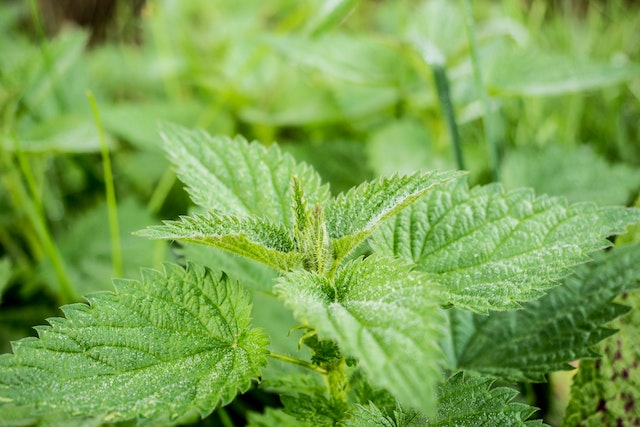Disclaimer: This Materia Medica is provided for informational purposes only and should not replace professional medical advice. Please consult with a qualified healthcare practitioner or herbalist before using any herbal remedies.
Materia Medica: Stinging Nettle (Urtica dioica)
Introduction:
The medicinal herb known as Urtica dioica or stinging nettle is held in high regard worldwide and is common in various temperate climates globally. Being an expert in herbalism, I have put together this comprehensive materia medica to offer detailed knowledge of stinging nettle. This includes its plant traits, historical usage, chemical structure, healing attributes, therapeutic uses, dosage guidelines, safety measures and possible reactions.
Botanical Description:
Family: Urticaceae
Genus: Urtica
Species: U. dioica
Common Names: Stinging nettle, common nettle
Habitat: Stinging nettle is typically seen in regions such as Europe, Asia, North America and some areas of Africa. This plant does well in damp soil enriched with nitrogen, commonly found in forests, beside rivers and in fields.
Plant Parts Used:
Leaves and roots from plants are predominantly used for health remedies.
Historical Use:
Stinging nettle has a rich history of use in traditional herbal medicine systems across the world:
Ancient civilizations like the Romans and Greeks treated joint pain and used nettle for its diuretic properties.
It was used by Native American tribes as a remedy for conditions such as arthritis, hay fever and urinary tract complications.
For centuries, nettle has been utilized by European herbalists to help cure various disorders such as allergies, anemia and skin problems.
Chemical Constituents:
Stinging nettle contains a diverse array of bioactive compounds, including:
- Flavonoids (quercetin, kaempferol)
- Tannins
- Amino acids (histidine, tryptophan)
- B complex vitamins and A, C & K.
- Minerals (iron, magnesium, calcium)
- Phytonutrients (chlorophyll, beta-carotene)
- Among organic acids are formic and acetic acids.
- Lipids (essential fatty acids)
Medicinal Properties:
- Anti-inflammatory
- Antioxidant
- Diuretic
- Adaptogenic
- Immunomodulatory
- Hemostatic (stops bleeding)
- Anti-allergenic
- Nutrient-dense
- Analgesic (pain-relieving)
- Antirheumatic
Therapeutic Applications:
Allergies: Seasonal allergies can be eased with the help of stinging nettle because it has antihistamine qualities. Symptoms like sneezing, runny nose and itching are lessened by it.
Arthritis and Joint Pain: The anti-inflammatory and pain-relieving effects of nettle are helpful in treating arthritis and other conditions that cause inflammation in the joints.
Anemia: Nettle is rich in iron and vitamin C allows it to enhance hemoglobin levels and help manage iron-deficiency anemia effectively.
Skin Conditions: Using nettles in the form of creams or extracts topically can help manage skin issues like eczema, psoriasis and acne.
Urinary Tract Health: As a diuretic, stinging nettle can potentially help treat kidney stones and urinary tract infections.
Prostate Health: Symptoms of benign prostatic hyperplasia (BPH) may be lessened with the help of nettle root supporting prostate health.
Menstrual Disorders: The regulation of menstrual cycles and relief from PMS symptoms can be achieved through nettle supplements or infusions.
Nutritional Support: The herb nettle is loaded with nutrients that foster health and liveliness when taken regularly.
Dosage and Precautions:
Dried leaves for tea: You can have a cup containing 2-4 grams up to thrice every day.
Tincture (1: The dosage recommendation for a solution with 45% alcohol content (5) is between 2 and 4 mL, which can be consumed up to thrice per day.
Nettle root tincture: Between 2 and 4 milliliters can be taken up to thrice per day.
Consider consulting with a healthcare provider to get accurate dosage recommendations especially for children and females who are pregnant or lactating as well as those individuals taking medications.
Potential Interactions:
There might be an interaction between stinging nettle and medications meant to thin the blood.
Nettle might decrease blood sugar levels so those who have diabetes must regulate their glucose levels constantly.
If you are undergoing treatment for hypertension or taking diuretics, consult with a healthcare professional about its usage.
Conclusion:
A plethora of medicinal benefits make the stinging nettle an indispensable component in the collection of any herbalist. The traditions of its use, the wealth of nutrients it provides and its versatile uses make it a highly respected component in natural medicine. Always be cautious when considering using nettle to treat certain medical conditions and seek advice from a qualified healthcare professional for individualized guidance.





